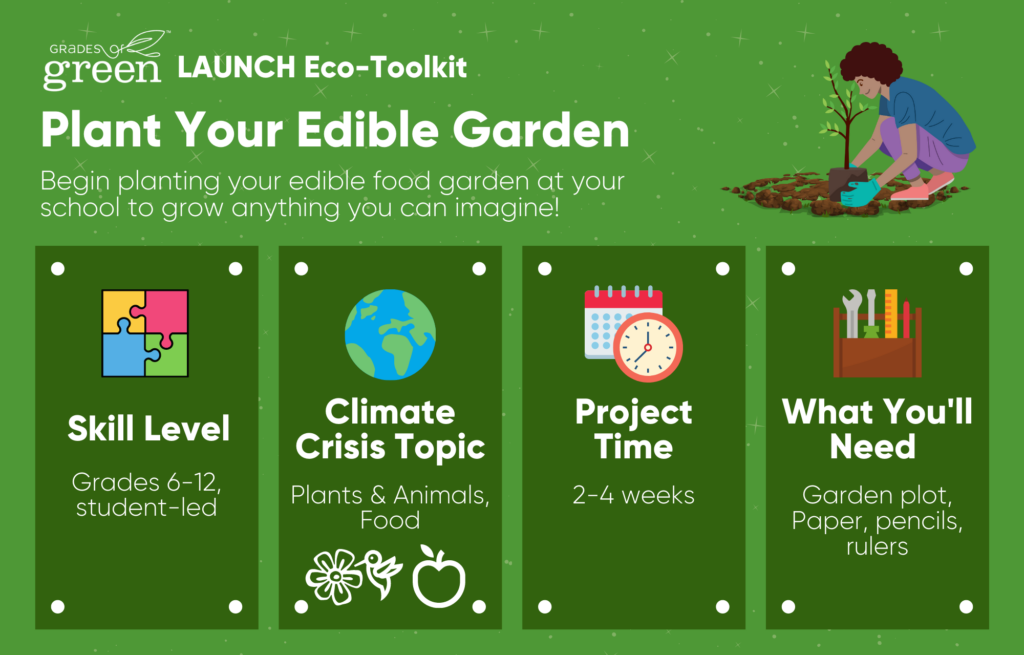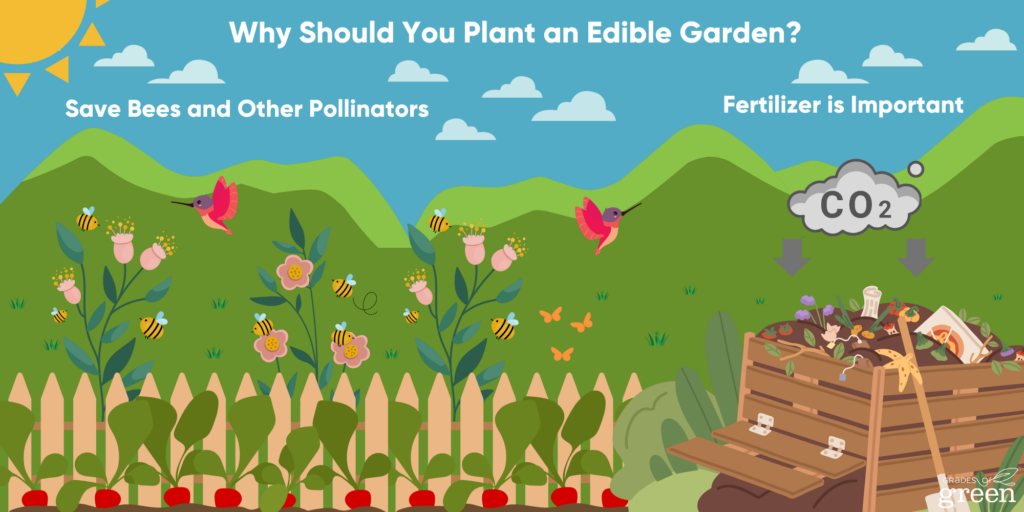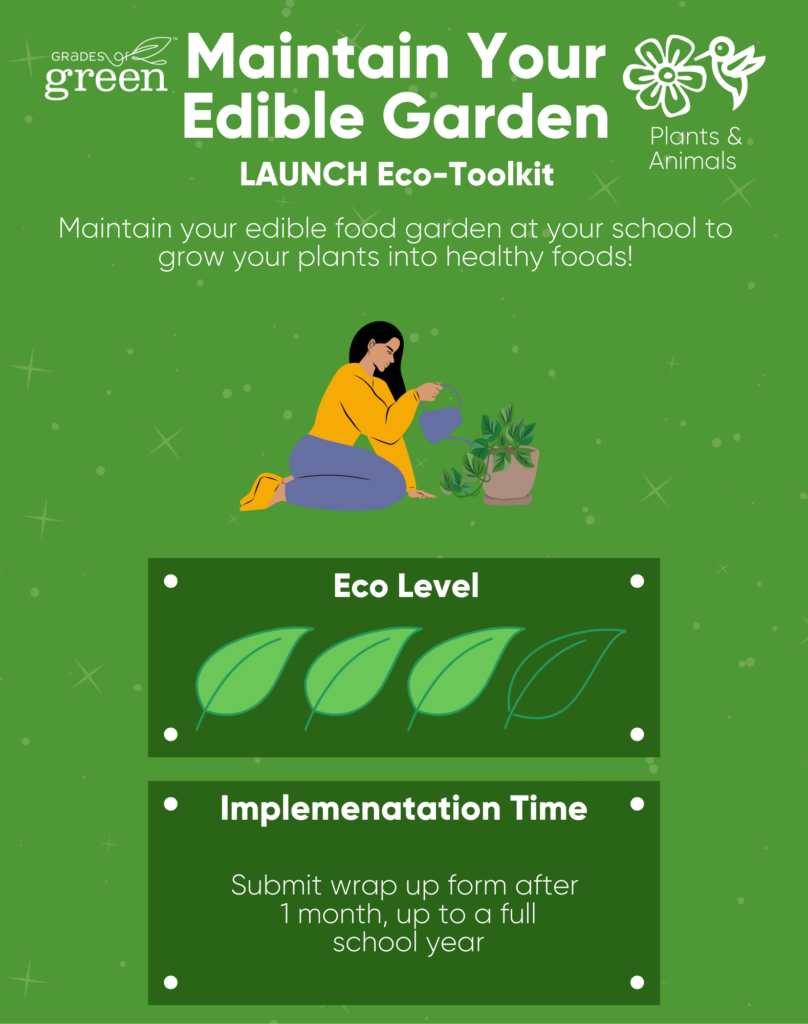You have your plan, now it’s time to PLANT!
In this second toolkit of the Edible Garden series, you will learn how to prepare your edible garden site and plant your seeds. You will also discover the positive impacts edible gardens have on the environment.
Grades of Green is proud to partner with Palos Verdes School Gardens and Kellogg Garden Products to bring you this toolkit.

Toolkit Details


NGSS
This toolkit address the following Science and Engineering Practices (SEPs) within the Performance Expectations of NGSS for Grades: 6-8 and 9-12
- Asking Questions and Defining a Problem
- Planning and Carrying out Investigations
- Analyzing and Interpreting Data
- Using Mathematics and Computational Thinking
- Constructing Explanations and Designing Solutions
- Obtaining Evaluating, and Communicating Information
Learning Objectives
- Analysis
- Students will analyze their edible garden and determine best practices for planting
- Project Management
- Students will manage and maintain their own garden planting session to develop project management skills
- Students will practice leadership skills by delegating tasks to each other
- Evaluation and Assessment
- Students will track and evaluate the impact of their edible garden
What is an Edible Garden and why is it important?
Having a school garden is a fun and educational experience that offers many benefits. It provides an opportunity to learn new skills while being outdoors, fostering teamwork, and promoting awareness of food systems, environmental responsibility, and stewardship. Gardens also encourage physical activity, and personal growth, and support mental and emotional well-being. They serve as a platform for community improvement and social awareness, and promote sustainable practices and healthier food choices. The school garden acts as a living lab, providing problem-solving opportunities and cultivating critical thinking skills. Overall, the edible school garden creates a vibrant space for learning and personal development and fosters a deeper connection with the natural world. (Source: KidsGardening)
What You Will Accomplish
Get ready to dig in and get your hands dirty as students take charge of preparing and planting their school’s incredible edible garden! You will start by testing the soil to unlock its secrets and understand its nutrient levels. With this knowledge in hand, you will carefully choose where each seed should be planted, creating a strategic layout for optimal growth. Then, it’s time to get hands-on as you gently plant the seeds. Together students will cultivate a vibrant and thriving garden that will nourish both bodies and minds. Let the gardening adventure begin!
Why Should You Plant an Edible Garden?
The resources provided below can be shown as a slideshow or printed out as individual worksheets for students to review. For more background learning, please refer to the Plan, Maintain, and Harvest your garden toolkits!

Save Bees and Other Pollinators
Edible gardens are not just delicious and nutritious, they also play a vital role in supporting local ecosystems. Pollinators, like bees, butterflies and birds, are superheroes for our planet. They help plants reproduce by transferring pollen from one flower to another, allowing them to bear fruits and vegetables. Unfortunately, pollinators are facing challenges, and one of the main culprits is pesticides. These chemicals harm pollinators, leading to their decline. But fear not aspiring gardeners! By growing your own fruits and vegetables organically, you can create a safe haven for these incredible creatures. Your edible garden becomes a buzzing paradise, attracting bees and other pollinators to do their magical work. So let’s skip harmful pesticides, and become champions for our pollinator friends and the Earth’s ecosystems. [1]
It’s Better For Your Body
By using organic fertilizer in the soil and avoiding synthetic fertilizers, herbicides, and pesticides, the microorganisms in the soil that sequester carbon can continue to thrive. Synthetic nitrogen fertilizer can cause nitrous oxide emissions, a greenhouse gas 300 times more potent than carbon dioxide. An organic garden has better soil quality, reducing fertilizer and pesticide run-off pollution. [2]
Why Food is an Environmental Justice Issue
Farmworkers play a vital role in our agricultural system, working tirelessly to ensure we have food on our tables. However, their work comes with significant risks, as they face exposure to toxic pesticides that threaten their lives, health, and the well-being of their children and communities. It is crucial that we take action to improve the working conditions for farmworkers and protect them from the harmful effects of pesticides. This includes advocating for stronger regulations, providing proper training and protective equipment, and promoting sustainable farming practices that reduce reliance on toxic chemicals. By standing together and prioritizing the safety and well-being of farmworkers we can strive for a more just and sustainable agricultural industry that respects and protects those who contribute to our food supply. [3]
Watch these short videos to learn more about planting a garden!
Think About It!
Pre-Activity Questions
- What are the benefits of preparing your soil?
- What are some of the environmental benefits that can be addressed in preparations and planting?
- What are some organizations we can connect with to get supplies and seeds?
Take Action: LAUNCH the Planting of Your Edible Garden
Follow the steps below to harvest a successful Edible Garden at your school! Need help? Contact us!
Step 1: Check Your Soil
Now that you have a plan for your garden, it’s time to give your seeds the best start by preparing the soil:
- If you are planting in-ground, make sure to test your soil. Follow Kellogg Garden’s How to Tell if Soil is Good with 8 Simple Tests. Use this guide to check the texture of your soil.
- Determine what type of soil you need. Different plants have different soil requirements, so it’s essential to choose the right mix.
- Use this Soil Calculator to figure out how much soil you will need
It’s important to understand the difference between garden soil and raised bed soil. Garden soil is suitable for planting directly in the ground, while raised bed soil is specially formulated for use in raised bed planters. Understanding the distinction will help you make the right choice for your specific gardening needs.
Step 2: Grab Your Grid
Now that you have your garden plan in hand, it’s time to bring it to life by creating defined lines in your garden beds. Refer to your Garden Grid from the first Plan Your Edible Garden Toolkit. Grab a garden trowel or use your hands to carefully “draw” lines in the soil according to the grid you made. This will help you organize and visualize the layout of your plants, ensuring they have their designated spaces to thrive.
Pro-Tip: To make your grid even more visible, you can use garden twine or string. Simply tie the string tightly between stakes or attach it to the edges of your garden bed to create straight and clear lines. This will serve as a helpful guide as you plant your seeds and seedlings, keeping everything neat and organized.
Step 3: Fertilize the Garden
Organic fertilizers are like nutritious meals for your plants! They’re made from natural sources like plants or animal products, and they offer some incredible benefits. Let’s dig into why organic fertilizers are great for plant nutrition:
- Just the right dose: Organic fertilizers are hard to overapply, which means you won’t accidentally overwhelm your plants with too much of a good thing.
- Microbe boosters: These fertilizers help nourish soil microbes, the tiny superheroes that work behind the scenes to break down organic matter and release nutrients for the plants. By feeding the soil microbes, you’re creating a thriving ecosystem underground.
- Soil structure: Organic fertilizers improve soil structure by enhancing its ability to hold water and nutrients. They build a strong foundation for your plants to grow deep and strong roots.
- People and planet friendly: Organic fertilizers are safer for both people and the environment. They’re free from harmful chemicals, ensuring that your garden stays healthy and sustainable.
- Compost: made from kitchen scraps and yard waste, it releases nutrients slowly over time, providing a steady supply of nourishment.
- Liquid seaweed: extracted from seaweed it’s rich in minerals and growth-promoting substances.
- Fish emulsion: Made from fish waste, this fertilizer is a fantastic source of nitrogen, phosphorus, and potassium. It’s like serving your plants a delicious fish feast!
- Bone meal: Made from ground animal bones this fertilizer is high in phosphorus, perfect for promoting root growth and flowering.
- Blood meal: made from dried animal blood, it’s packed with nitrogen, promoting lots of green growth
- Alfalfa meal: Ground from alfalfa plants, this superhero fertilizer contains a range of nutrients, including nitrogen, phosphorus, and potassium. It’s a great plant based meal!
- Composted manure: This fertilizer is created by decomposing animal manure over time.
Remember, good soil is the foundation for healthy plants. Continue to test your soil to ensure your pH levels are balanced for your chosen plants. This way they can effectively absorb the nutrients they need to thrive. While organic fertilizers provide a great nutrient boost, keep and eye on your plants for signs of growth and health. Some plants may need additional fertilizing throughout the growing season, so be attentive to their needs.
The three major nutrients that plants require are:
- Nitrogen: it’s crucial for promoting growth and keeping leaves green and vibrant
- Phosphorus: helps develop strong roots, encourages flower and fruit production and boosts disease resistance.
- Potassium: supports overall plant health, aids in fruit ripening, and enhances disease resistance.
With the power of organic fertilizers and a good understanding of plant nutrition, you can provide your garden with the nutrients it needs to thrive and become the envy of all other gardens!
- Edible garden plants like to bed fed every 2-4 weeks with a liquid or granular organic fertilizers
Step 4: Starting the Seeds
To get you starting seeds on the right track, check out this video that provides great tips and techniques. Remember, you can get creative and repurpose small plant containers, cardboard egg cartons, or even milk cartons to give your seeds a cozy home.
- To plant your seeds, use two fingers to create small holes in the soil. Drop a few seeds into each hole and cover them with soil, making sure they are at the appropriate depth for the specific seed type.
- Next, give your seeds a drink by watering the soil. Remember to keep the soil consistently moist as the seeds germinate and the seedlings grow.
- Once your seedlings have grown strong and sturdy, it’s time to transplant them into your garden. Gently transfer them from their containers, being careful not to disturb the roots, and place them in the prepared soil of your garden beds or containers.
If you have used cardboard egg cartons to plant your seeds you can simply cut the individual cups apart, make a hole in the bottom (being careful not to tear the roots of the seedling) and plant the cardboard carton directly into the ground. This makes it easier to transplant and causes less disruption to your seedling.
Consider practicing succession planting as well! Instead of planting all your seeds at once, try planting a portion of them every week. This way, you’ll have a continual harvest throughout the season, ensuring a steady supply of fresh produce.
Reflection Questions
How’d It Go?
- What was the most challenging part of the planting process?
- Which next step are you most excited about?
- Why is planting an edible garden beneficial to the Climate Crisis?
Report Students’ Impact
Congratulations!! You’ve planted your edible garden! Don’t let all that hard work go unnoticed. Submit your results by clicking the green button below.
Project ongoing? No problem! Let us know what you’ve done so far.
By reporting your impact, Grades of Green can:
- CELEBRATE and elevate your students’ hard work and success.
- Offer our programs FREE for all students across the globe.
- AWARD stipends and certificates to hard-working educators and students.
Please take a few minutes to submit your results. Thank you!
Next Steps
Congrats on Planting Your Edible Garden! Get started on Toolkit #3: Maintain Your Edible Garden!

Provided Resources
- Edible Garden Series Google Resources
- Edible Garden Sign-Up Sheet
- Edible Garden Grid Plan
- Edible Garden Plant Wrap-Up Form
- Harvest and Sustain Slideshow
- Kellogg Harvesting Guide
- Kellogg Activities for kids with printouts
Congrats on completing the PLANT Your Edible School Garden Toolkit! By finishing this toolkit, you have equipped yourself with the knowledge and tools to embark on an exciting journey of creating an edible garden at your school. Now it’s time to get ready to dig in and have fun and witness the beauty and abundance that your school garden will bring!
Did you enjoy this toolkit? Get ready to maintain your edible garden!